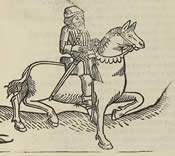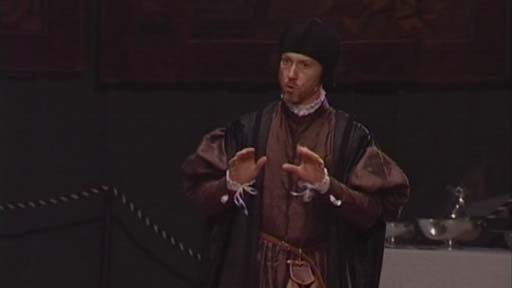Description of a Merchant from the General Prologue to The Canterbury Tales

The merchant from Caxton's second
edition of The Canterbury Tales.
The British Library G. 11586, f.i7 v.
Chaucer's description of The Merchant from the 'General Prologue' to the Canterbury Tales is a useful depiction of this emergent class. His failure to name his Merchant points up something of the difficulty of locating this group of people among the estate satire of both Chaucer and Heywood. The lack of naming and the motley dress also gesture towards fool or jester constructions in this excerpt (lines 270-284).
A Marchant was ther, with a forked berd,
In mottelee, and hye on horse he sat,
Upon his heed a Flaundryssh bever hat.
His bootes clasped faire and fetisly.
Hise resons he spak ful solempnely,
Sownynge alway thencrees of his wynnyng.
He wolde the see were kept for any thyng
Bitwixe Middelburgh and Orewelle.
Wel koude he in eschaunge sheeldes selle.
This worthy man ful wel his wit bisette;
There wiste no wight that he was in dette,
So estatly was he of his governaunce,
With his bargaynes and with his chevyssaunce.
Forsothe, he was a worthy man with-alle
But, sooth to seyn, I noot how men hym calle.
The antithetical nature of the merchant class to the ethos of the court is also highlighted by Fancy's lines in John Skelton's Magnyfycence: "Measure is meet for a merchant's hall/ But largesse becometh a state royal" (lines 382-3).
References : Geoffrey Chaucer, The College Chaucer, Henry Noble MacCracken, ed. (Yale University Press, 1913) pp. 8-9.










